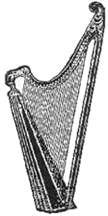|
             
Copyright
Helen Forder
2004
|
|
The Harp, by Brinley Richards, Esq.
(from - Y Cymmrodor, April 1877)
|
|
Among national instruments
of music, the place of honour must undoubtedly be assigned to the Harp;
and, although its tones have long since died away in Scotland and Ireland,
they are still heard in the country with which its name has been associated
from the earliest records of its history. But even in Wales its use has
been gradually declining; and had it not been for the patriotic efforts of
Lady Llanover, it is probable that "the distinctive instrument of an
old and haughty nation, proud in arms", would long since have
disappeared. But while compelled to say, in the words of Walter Scott:-
"Receding now the dying numbers ring,
Fainter and fainter down the rugged dell;"
we trust we shall not have to add with
him,
"And now 'tis silent all: -
Enchantress, fare thee well."
|

Triple Harp
|
|
In writing on the Harp, it
is clear we have to deal with the combined subjects of nationality and
music; and we preface our paper with remarking it to be somewhat curious,
that while strenuous efforts are being made to uphold the national
instrument of Scotland, such little interest should be shown in preserving
the Harp of Wales. Considered simply as a question of sound, the bag-pipes
have claims which, if not musical, are assuredly boisterous. But even in
Scotland the pipes were not always in favour. In 1630 the Magistrates of
Aberdeen "discharged the common piper
going through the town, it being an uncivill forme to be usit within sic a
famous burghe". Nor can we wonder
at this, if we are to accept a statement in Sir John Dalyell's memoirs of
Scotland, "that a bag-pipe in
possession of the Duke of Sutherland, during the Rebellion of 1775, was so
loud as to be heard eight miles".
|
|
Compared with modern
instruments, the harp is placed at a disadvantage, in consequence of the
expense of stringing and tuning - strings being so easily affected by
atmospheric influences. In a debate before the Privy Council on the
accession of James I, about quartering the Royal arms, it was decided that
the harp of Ireland should be in the third quarter. The Earl of
Northampton, who had little affection for the Irish, remarked "that the best reason for the bearing was, that it
resembled the country in being such an instrument that it required more
cost to keep it in tune than it was worth".
|
|
back 1 2 3 4 5 6 7 8 next
|
|

